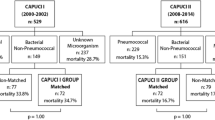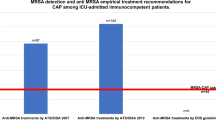Abstract
Background
It remains uncertain why immunocompetent patients with bacterial community-acquired pneumonia (CAP) die, in spite of adequate antibiotics.
Methods
This is a secondary analysis of the CAPUCI database which was a prospective observational multicentre study. Two hundred and twelve immunocompetent patients admitted to 33 Spanish ICUs for CAP were analyzed. Comparisons were made for lifestyle risk factors, comorbidities and severity of illness. ICU mortality was the principal outcome variable.
Results
Bacteremic CAP (43.3 vs. 21.1%) and empyema (11.5 vs. 2.2%) were more frequent (P < 0.05) in patients with Streptococcus pneumoniae CAP. Higher rates of adequate empiric therapy (95.8 vs. 75.5%, P < 0.05) were observed in patients with S. pneumoniae CAP. Patients with non-pneumococcal CAP experienced more shock (66.7 vs. 50.8%, P < 0.05), and need for mechanical ventilation (83.3 vs. 61.5%, P < 0.05). ICU mortality was 20.7 and 28% [OR 1.49(0.74–2.98)] among immunocompetent patients with S. pneumoniae (n = 122) and non-pneumococci (n = 90), in spite of initial adequate antibiotic. Multivariable regression analysis in these 184 immunocompetent patients with adequate empirical antibiotic treatment identified the following variables as independently associated with mortality: shock (HR 13.03); acute renal failure (HR 4.79), and APACHE II score higher than 24 (HR 2.22).
Conclusions
Mortality remains unacceptably high in immunocompetent patients admitted to the ICU with bacterial pneumonia, despite adequate initial antibiotics and comorbidities management. Patients with shock, acute renal failure and APACHE II score higher than 24 should be considered for inclusion in trials of adjunctive therapy in order to improve CAP survival.


Similar content being viewed by others
References
Restrepo MI, Jorgensen JH, Mortensen EM, Anzueto A (2001) Severe community-acquired pneumonia: current outcomes, epidemiology, etiology and therapy. Curr Opin Infect Dis 14:703–709
Bauer TT, Welte T, Ernen C, Schlosser BM, Thate-Waschke I, de Zeeuw J, Schultze-Werninghaus G (2005) Cost analyses of community-acquired pneumonia from the hospital perspective. Chest 128:2238–2246
Restrepo MI, Mortensen EM, Velez JA, Frei C, Anzueto A (2008) A comparative study of community-acquired pneumonia patients admitted to the ward and the ICU. Chest 133:610–617
Lujan M, Gallego M, Rello J (2006) Optimal therapy for severe pneumococcal community-acquired pneumonia. Intensive Care Med 32:971–980
Rello J, Rodriguez R, Jubert P, Alvarez B (1996) Severe community-acquired pneumonia in the elderly: epidemiology and prognosis. Study Group for Severe Community-Acquired Pneumonia. Clin Infect Dis 23:723–728
Restrepo MI, Anzueto A (2006) The role of new therapies for severe community-acquired pneumonia. Curr Opin Infect Dis 19:557–564
Frei CR, Restrepo MI, Mortensen EM, Burgess DS (2006) Impact of guideline-concordant empiric antibiotic therapy in community-acquired pneumonia. Am J Med 119:854–871
Rello J, Rodriguez A, Torres A, Roig J, Sole-Violan J, Garnacho-Montero J, de la Torre MV, Sirvent JM, Bodi M (2006) Implications of COPD in patients admitted to the intensive care unit by community-acquired pneumonia. Eur Respir J 27:1210–1216
Blot SI, Rodriguez A, Sole-Violan J, Blanquer J, Almirall J, Rello J (2007) Effects of delayed oxygenation assessment on time to antibiotic delivery and mortality in patients with severe community-acquired pneumonia. Crit Care Med 35:2509–2514
Rello J, Catalan M, Diaz E, Bodi M, Alvarez B (2002) Associations between empirical antimicrobial therapy at the hospital and mortality in patients with severe community-acquired pneumonia. Intensive Care Med 28:1030–1035
Waterer GW, Kessler LA, Wunderink RG (2006) Delayed administration of antibiotics and atypical presentation in community-acquired pneumonia. Chest 130:11–15
Bodi M, Rodriguez A, Sole-Violan J, Gilavert MC, Garnacho J, Blanquer J, Jimenez J, de la Torre MV, Sirvent JM, Almirall J, Doblas A, Badia JR, Garcia F, Mendia A, Jorda R, Bobillo F, Valles J, Broch MJ, Carrasco N, Herranz MA, Rello J (2005) Antibiotic prescription for community-acquired pneumonia in the intensive care unit: impact of adherence to Infectious Diseases Society of America guidelines on survival. Clin Infect Dis 41:1709–1716
Rello J, Bodi M, Mariscal D, Navarro M, Diaz E, Gallego M, Valles J (2003) Microbiological testing and outcome of patients with severe community-acquired pneumonia. Chest 123:174–180
Bartlett JG, Dowell SF, Mandell LA, File TM Jr, Musher DM, Fine MJ (2000) Practice guidelines for the management of community-acquired pneumonia in adults. Infectious Diseases Society of America. Clin Infect Dis 31:347–382
Ognibene FP (1996) Hemodynamic support during sepsis. Clin Chest Med 17:279–287
Marik P, Varon J (1998) The hemodynamic derangements in sepsis: implications for treatments strategies. Chest 114:854–860
Laterre PF, Garber G, Levy H, Wunderink R, Kinasewitz GT, Sollet JP, Maki DG, Bates B, Yan SC, Dhainaut JF, PROWESS Clinical Evaluation Committee (2005) Severe community-acquired pneumonia as a cause of severe sepsis: data from the PROWESS study. Crit Care Med 33:952–961
Garcia-Vidal C, Calbo E, Pascual V, Ferrer C, Quintana S, Garau J (2007) Effects of systemic steroids in patients with severe community-acquired pneumonia. Eur Respir J 30:951–956
Gorman SK, Slavik RS, Marin J (2007) Corticosteroid treatment of severe community-acquired pneumonia. Ann Pharmacother 41:1233–1237
Wunderink RG, Waterer GW (2004) Community-acquired pneumonia: pathophysiology and host factors with focus on possible new approaches to management of lower respiratory tract infections. Infect Dis Clin North Am 18:743–759
Glück T, Opal SM (2004) Advances in sepsis therapy. Drugs 64:837–859
Waterer GW, Somes GW, Wunderink RG (2001) Monotherapy may be suboptimal for severe bacteremic pneumococcal pneumonia. Arch Intern Med 161:1837–1842
Waterer GW, Rello J (2006) Choosing the right combination therapy in severe community-acquired pneumonia. Crit Care 10:115
Waterer GW, Buckingham SC, Kessler LA, Quasney MW, Wunderink RG (2003) Decreasing beta-lactam resistance in Pneumococci from the Memphis region: analysis of 2,152 isolates from 1996 to 2001 Chest 124:519–525
Rodríguez A, Mendia A, Sirvent JM, Barcenilla F, de la Torre-Prados MV, Solé-Violán J, Rello J, CAPUCI Study Group (2007) Combination antibiotic therapy improves survival in patients with community-acquired pneumonia and shock. Crit Care Med 35:1493–1498
Wunderink RG (2006) A CAP on antibiotic duration. Am J Respir Crit Care Med 174:3–5
Dunbar LM, Wunderink RG, Habib MP, Smith LG, Tennenberg AM, Khashab MM, Wiesinger BA, Xiang JX, Zadeikis N, Kahn JB (2003) High-dose, short-course levofloxacin for community-acquired pneumonia: a new treatment paradigm. Clin Infect Dis 37:752–760
Bernard GR, Vincent JL, Laterre PF, LaRosa SP, Dhainaut JF, Lopez-Rodríguez A, Steingrub JS, Garber GE, Helterbrand JD, Ely EW, Fisher CJ Jr, Recombinant human protein C worldwide evaluation in severe sepsis (PROWESS) study group (2001) Efficacy and safety of recombinant human activated protein C for severe sepsis. N Engl J Med 344:699–709
Houck PM, Bratzler DW, Nsa W, Ma A, Bartlett JG (2004) Timing of antibiotic administration and outcomes for medicare patients hospitalized with community-acquired pneumonia. Arch Intern Med 164:637–644
Hoste EAJ, Clermont G, Kersten A, Venkataraman R, Angus DC, De Bacquer D, Kellum JA (2006) RIFLE criteria for acute kidney injury are associated with hospital mortality in critically ill patients: a cohort analysis. Crit Care 10:R73
Rodríguez A, Rello J (2008) Assessment of severity in patients with community-acquired pneumonia. Intensive Care Med 34:968
Waterer GW, Kessler LA, Wunderink RG (2004) Medium-term survival after hospitalization with community-acquired pneumonia. Am J Respir Crit Care Med 169:910–914
Roberts JA, Lipman J (2006) Antibacterial dosing in intensive care: pharmacokinetics, degree of disease and pharmacodynamics of sepsis. Clin Pharmacokinet 45:755–773
Shorr AF, Wunderink R (2008) There is no “CAP” on the importance of community-acquired pneumonia in the ICU. Chest 133:590–592
Restrepo MI, Bienen T, Mortensen EM, Anzueto A, Metersky ML, Escalante P, Wunderink RG, Mangura BT (2008) Evaluation of ICU admission criteria and diagnostic methods for patients with severe community-acquired pneumonia: current practice survey. Chest 133:828–829
Acknowledgments
We are indebted to Montserrat Olona for statistical advice and critical review of the manuscript. This study has been supported in part by Health Research Founds (FISS PI 04/1500 and FISS 05/2401), Generalitat de Catalunya Grant (SGR 05/920), and CIBER Enfermedades Respiratorias (CIBERES) by Carlos III Health Institute Grant.
Conflict of interest statement
Dr Rello serves as consultant and in the speakers Bureau for Novartis. The remaining authors declare that they have no competing interest.
Author information
Authors and Affiliations
Consortia
Corresponding author
Additional information
This article is discussed in the editorial available at: doi:10.1007/s00134-008-1366-3.
Electronic supplementary material
Below is the link to the electronic supplementary material.
134_2008_1363_MOESM1_ESM.doc
Table A Diagnostic examinations performed in 212 immunocompetent patients with bacterial community-acquired pneumonia distributed according to the causative aetiology. (supplementary electronic material) (DOC 47 kb)
The CAPUCI study investigators
The CAPUCI study investigators
J. Solé-Violan (Dr. Negrin Hospital, Gran Canaria), J. Blanquer (Clinic Hospital, Valencia), J. Jiménez (Virgen Del Rocio Hospital, Seville), V. de la Torre (Virgen De La Victoria Hospital, Malaga), J. M. Sirvent (Josep Trueta Hospital, Girona), M. Bodí (Joan XXIII Hospital, Tarragona), J. Almirall (Mataró Hospital, Mataró, Barcelona), A. Doblas (Juan Ramon imenez Hospital, Huelva), J. R. Badía (Clinic Hospital, Barcelona), F. García (General Hospital, Albacete), A. Mendia (Nuestra Señora de Aranzazu Hospital, San Sebastian), R. Jordá (Son Dureta Hospital, Palma de Mallorca), F. Bobillo (Clinico Hospital, Valladolid), J. Vallés (Hospital Parc Tauli, Sabadell, Barcelona), M. J. Broch (Sagunto Hospital, Valencia), N. Carrasco (Princesa Hospital, Madrid), M. A. Herranz (Rio Hortega Hospital, Valladolid), F. Alvarez Lerma (Del Mar Hospital, Barcelona), E. Messales (Trias i Pujol Hospital, Badalona, Barcelona), B. Alvarez (General Hospital, Alicante), J. C. Robles (Reina Sofia Hospital, Córdoba), E. Maravi (Virgen Del Camino Hospital, Pamplona), F. Barcenilla (Arnau de Vilanova Hospital, Lleida), M. A. Blasco (Peset Aleixandre Hospital, Valencia), G. Masdeu (Verge de la Cinta Hospital, Tortosa, Tarragona), M. J. López Pueyo (General Yague Hospital, Burgos), A. Margarit (Virgen Meritxell Hospital, Andorra), J. Fierro (Poniente Hospital, Almeria), F. Renedo (Leon Hospital, Leon), A. Lores (Bellvitge Hospital, Barcelona), R. Alonso (General de Asturias Hospital, Oviedo), M. J. Huertos (Puerto Real Hospital, Cadiz), and M. J. López (General Hospital, Segovia).
Rights and permissions
About this article
Cite this article
Rodriguez, A., Lisboa, T., Blot, S. et al. Mortality in ICU patients with bacterial community-acquired pneumonia: when antibiotics are not enough. Intensive Care Med 35, 430–438 (2009). https://doi.org/10.1007/s00134-008-1363-6
Received:
Accepted:
Published:
Issue Date:
DOI: https://doi.org/10.1007/s00134-008-1363-6




